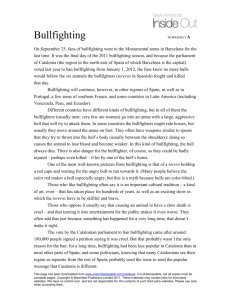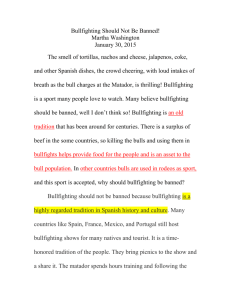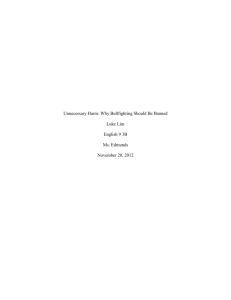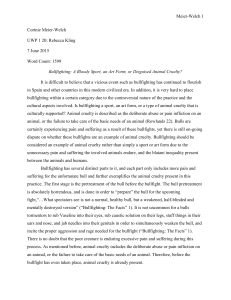Name: 李雪溱 Shirley Lee Professor: Michael Cheng Research
advertisement
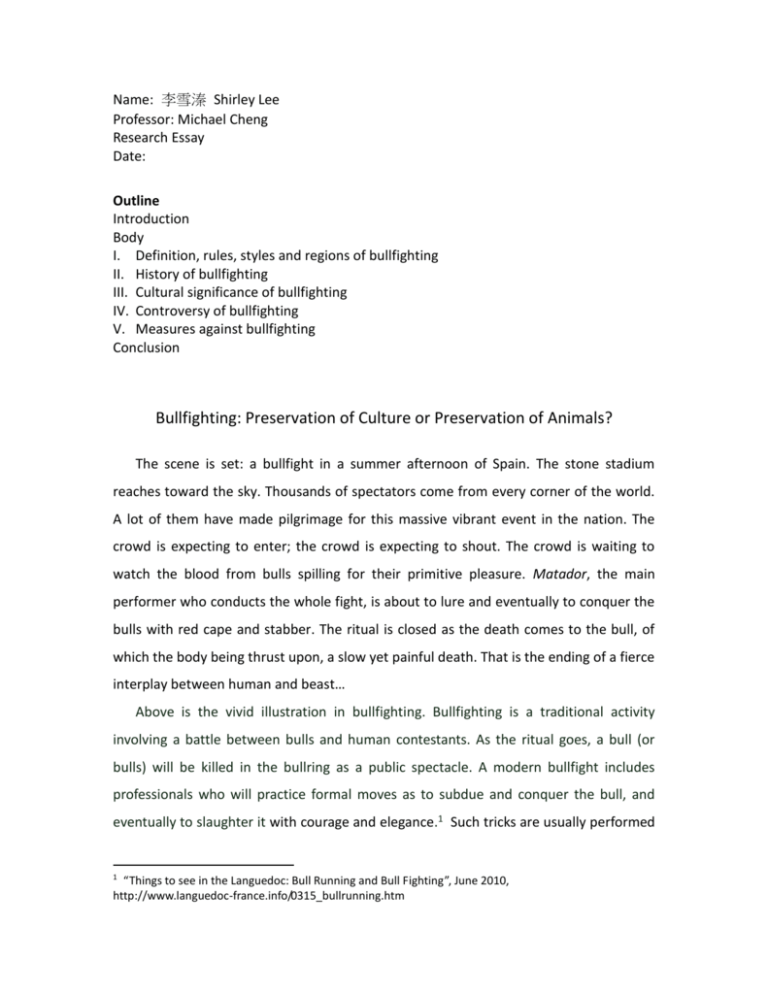
Name: 李雪溱 Shirley Lee Professor: Michael Cheng Research Essay Date: Outline Introduction Body I. Definition, rules, styles and regions of bullfighting II. History of bullfighting III. Cultural significance of bullfighting IV. Controversy of bullfighting V. Measures against bullfighting Conclusion Bullfighting: Preservation of Culture or Preservation of Animals? The scene is set: a bullfight in a summer afternoon of Spain. The stone stadium reaches toward the sky. Thousands of spectators come from every corner of the world. A lot of them have made pilgrimage for this massive vibrant event in the nation. The crowd is expecting to enter; the crowd is expecting to shout. The crowd is waiting to watch the blood from bulls spilling for their primitive pleasure. Matador, the main performer who conducts the whole fight, is about to lure and eventually to conquer the bulls with red cape and stabber. The ritual is closed as the death comes to the bull, of which the body being thrust upon, a slow yet painful death. That is the ending of a fierce interplay between human and beast… Above is the vivid illustration in bullfighting. Bullfighting is a traditional activity involving a battle between bulls and human contestants. As the ritual goes, a bull (or bulls) will be killed in the bullring as a public spectacle. A modern bullfight includes professionals who will practice formal moves as to subdue and conquer the bull, and eventually to slaughter it with courage and elegance.1 Such tricks are usually performed 1 “Things to see in the Languedoc: Bull Running and Bull Fighting”, June 2010, http://www.languedoc-france.info/0315_bullrunning.htm at close distance, which may result in injuries or death of the bullfighter at times. Bullfighting can be risky and dangerous to bullfighters’ lives especially during the process of manipulating and killing the bull and maintaining an aesthetic form. The tradition of bullfighting is mostly practiced in Spanish-speaking countries, Portugal and southern France, yet such bull races also take place in Korea, Japan and some parts of Middle East.2 Styles of bullfighting vary, however the Spanish style, in which the bull gets physically injured and the matador gets cheered for before the crowds, has become the most common way to bullfight.3 There has been a long history behind the bull event. It could be dated back to prehistoric times, when the bulls were served as religious means. As mythology goes, killing the sacred bull Minotaur has been an iconic act to commemorate the god Mithras in the Roman Empire, which appeared to be one of the early forms of bullfighting. 4 Bullfights were also seen in venues of Rome, for there were a great amount of competitions between animals and humans at that time. In the fifteen century, bullfighting was spread to the colonies in Latin America from Spain; to the territory in France around the nineteenth century.5 Bullfighting even underwent a huge transition, from horseback fight to on-foot bullfight, in the eighteenth century.6 The new style, with the invention of permanent bullrings and of new equipment such as a sword and a cape, plays a key role in the outlook of modern bullfight.7 During the eighteenth and nineteenth centuries, bullfighting was abolished most notably by Philip V., for he considered it inappropriate for the noble. Thus, bullfighting has turned out an activity 2 Encyclopædia Britannica: Bullfighting, June 2010, http://www.britannica.com/EBchecked/topic/84444/bullfighting 3 Wikipedia: “Spanish-style bullfighting”, June 2010, http://en.wikipedia.org/wiki/Spanish-style_bullfighting#Parts_of_a_bullfight 4 Encyclopædia Britannica: Mithraism, June 2010, http://www.britannica.com/EBchecked/topic/386080/Mithraism 5 “Colonial Period - European Settlement Of North America, Factors Influencing Early Colonial Law, Differences From The English Criminal Justice System”, June 2010, http://law.jrank.org/pages/11887/Colonial-Period.html 6 Love Customs in Eighteenth-Century Spain, by Carmen Martín Gaite, 1991, http://publishing.cdlib.org/ucpressebooks/view?docId=ft6x0nb4m5;chunk.id=0;doc.view=print 7 “Spanish Bullfighting: The Romance, the Drama and the Traditional Recipes”, by Justin Roberts, Feb. 2010, http://catavino.net/culture/spanish-bullfighting-the-romance-the-drama-and-the-traditional-recipes/ suitable for common people after the incident.8 The prolonged background makes bullfighting not just an ordinary activity, but a tradition with cultural significance and meaning in some regions or countries. For the advocates of the tradition, bullfighting has been deeply ingrained, an integral part of their national culture. They believe bullfighting is not a sport which competes by the accumulation of score, but the appreciation of artistic form based on the interaction of men and bulls.9 In addition, the practice of bullfighting involves the local language. For instance, in Spain and other Spanish-speaking countries, people would cry out Olé to cheer for matadors when the bull charges through the cape.10 Bullfighting also involves ancient traditions. The bullfighters on horses still wear the sixteenth-century traditional attire to ask for starting a bullfight.11 People who uphold bullfighting regard it as a historic and indispensable custom for themselves. Esperanza Aguirre, a Spanish conservative politician, calls on UNESCO to declare bullfighting as one of the world’s cultural heritage.12 On the other hand, as the consciousness of nature preservation and animal rights is arising, opponents of bullfighting strive to ban the activity. Bullfighting is criticized mainly for the animal concerns. Animal rights activists deem bullfighting as the blood sport of cruelty and barbarism, where the bulls suffer from a torturous and painful death. In order to weaken a bull, the bullfighting crew place sandbags on bulls’ backs, or use special drug which would decrease animals’ strength.13 A study reports that twenty percents of the bulls used for fighting are drugged before the performance. 14 Another 8 Guardian: “Why bullfighting is making Spain see red”, by Paul Richardson, June 2010, http://www.guardian.co.uk/world/2010/jun/06/bullfighting-outlawed-catalonia 9 “Bullfighting culture as opposition to bullfighting cruelty”, Jan. 2006, http://www.syl.com/travel/bullfightingcultureasoppositiontobullfightingcruelty.html 10 andalucia.com: bullfighting terms, June 2010, http://www.andalucia.com/bullfight/bullfighting-terms.htm 11 The Last Arena: “Madrid: first bullfight, last bullfight”, by Alexander Fiske-Harrison, March 2009, http://fiskeharrison.wordpress.com/2008/10/25/29/ 12 V(otum) S(olvit) L(ibens) M(erito): “Spanish bullfighting should be given UNESCO protection?”, by Dis Manibus, March 2010, http://votumsolvit.com/2010/03/06/spanish-bullfighting-should-be-given-unesco-protection/ 13 “Running of the Bulls’ Factsheet”, June 2010, http://www.runningofthenudes.com/bullfighting_facts.asp 14 Reuters: “One-Fifth of Spain’s Fighting Bulls Drugged?”, Nov 2000 common practice is to saw off bulls’ horns as to impair the coordination. Despite some events entitled with “bloodless bullfighting”, bulls are actually put in great pain by the punctuation into bull’s back. The action might not kill the bull, but it is enough to hurt the bull, which violates the law of animal rights.15 The bull is not the only being that suffers in the ring. Horses, usually being ridden by picadors(matadors on horseback) while fighting against bulls, sometimes receive agonizing deaths from the gore of bull horn.16 Also, matadors might get severely injured for they are sometimes gored by bulls.17 In regard to the disproval of “blood sport,” various measures are taken to go against bullfighting. The state-run television Televisión Española in Spain no longer broadcasts live bullfights in any of the channels on its network, claiming it is too violent to watch for children.18 This is considered a milestone for the abolition of bullfighting. Moreover, bullfighting is banned in many countries. Some parts of Portugal have started prohibiting bullfighting since 2009 out of the factor of torturous and unjustifiable suffering.19 The province of Spain, Catalonia, passes the proposal for the legislation to ban bullfighting in 2009, as a response to thousands of signatures of anti-bullfighting petition.20 On top of these, Barcelona passes symbolic vote opposing to bullfighting, which indicates a big step forwards banning bullfights.21 Besides, a bill was introduced to prohibit bullfighting 15 Los Angeles Times: “Animal activists cry foul over ‘bloodless bullfighting’ event in Artesia”, by Lindsay Barnett, May 2009, http://latimesblogs.latimes.com/unleashed/2009/05/animal-activists-cry-foul-over-bloodless-bullfighting-e vent-in-artesia.html 16 “Bullfighting: The Facts”, June 2010, http://www.stopbullfighting.org.uk/facts.htm 17 National Turk: “Spanish bull fighter suffers horrific injury as bulls horn enters beneath the chin and comes out of”, May 2010, http:// www.nationalturk.com/en/bullfight-injury-as-matador-gored-through-chin-in-madrid-spain-56646415 18 Boston Herald: “No more ’olé’? Matadors miffed as Spain removes live bullfighting from state TV”, by Associated Press, August 2007, http://www.bostonherald.com/news/international/europe/view.bg?articleid=1018501&srvc=next_article 19 News 24:” Landmark bullfighting ban”, March 2009, http://www.news24.com/World/News/Landmark-bullfighting-ban-20090303 20 BBC News: “Spain's Catalonia backs debate on bullfighting ban”, by Dec. 2009, http://news.bbc.co.uk/2/hi/8421339.stm 21 Guardian: “Barcelona Passes Symbolic Vote Against Bullfighting”, by Giles Tremlett, April 2004, http://www.guardian.co.uk/world/2004/apr/07/animalwelfare.spain in Mexico, whose legislation is supported by animal activist groups.22 The issue of bullfighting will hardly come to an end since the two major sides of the issue—the preservation of culture and the preservation of animals, both have reasonable factor to demonstrate their point of view. Bullfighting has become a culturally important tradition in many parts of the world for centuries. Thus, it is nearly out of question to eliminate the activity right away without upsetting anyone or any group. On the other hand, as the concept of animal preservation is being much valued nowadays, the practice of bullfighting is being doubted mainly owning to the inhumane treatment to animals. Some regions in the world have legislated to ban bullfighting, and several TV stations have cut off the broadcasting of bullfights as to show opposition to bullfighting. As the debate over bullfighting is getting heated, bullfights might be facing an uncertain future. 22 Latin American Herald Tribune: “Animal Rights Activists Protest Bullfighting in Mexico”, 2010 June, http://laht.com/article.asp?ArticleId=351823&CategoryId=13003
